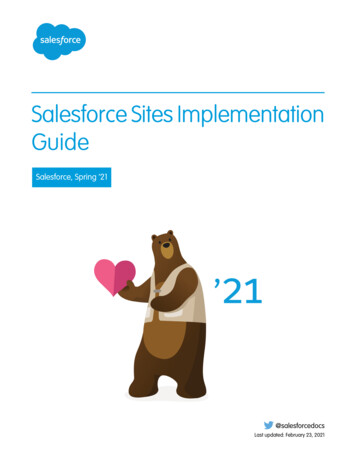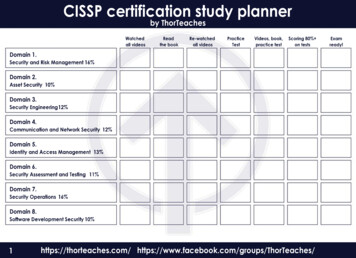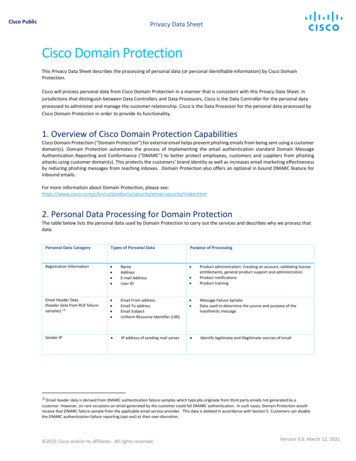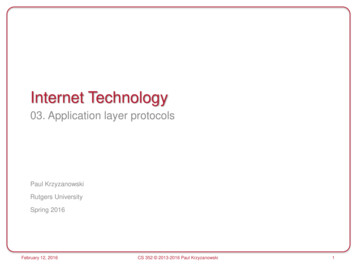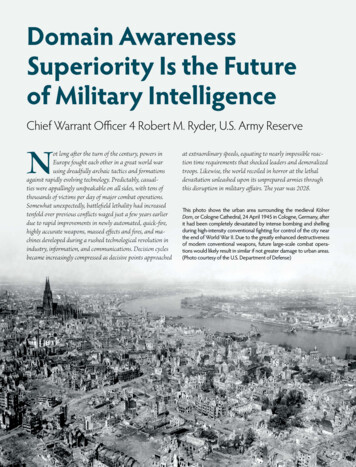
Transcription
Domain AwarenessSuperiority Is the Futureof Military IntelligenceChief Warrant Officer 4 Robert M. Ryder, U.S. Army ReserveNot long after the turn of the century, powers inEurope fought each other in a great world warusing dreadfully archaic tactics and formationsagainst rapidly evolving technology. Predictably, casualties were appallingly unspeakable on all sides, with tens ofthousands of victims per day of major combat operations.Somewhat unexpectedly, battlefield lethality had increasedtenfold over previous conflicts waged just a few years earlierdue to rapid improvements in newly automated, quick-fire,highly accurate weapons, massed effects and fires, and machines developed during a rushed technological revolution inindustry, information, and communications. Decision cyclesbecame increasingly compressed as decisive points approachedat extraordinary speeds, equating to nearly impossible reaction time requirements that shocked leaders and demoralizedtroops. Likewise, the world recoiled in horror at the lethaldevastation unleashed upon its unprepared armies throughthis disruption in military affairs. The year was 2028.This photo shows the urban area surrounding the medieval KölnerDom, or Cologne Cathedral, 24 April 1945 in Cologne, Germany, afterit had been completely devastated by intense bombing and shellingduring high-intensity conventional fighting for control of the city nearthe end of World War II. Due to the greatly enhanced destructivenessof modern conventional weapons, future large-scale combat operations would likely result in similar if not greater damage to urban areas.(Photo courtesy of the U.S. Department of Defense)
(Screenshot of motion graphic by William Norris, U.S. Army Training Support Center)Figure 1. U.S. Army in Multi-Domain Operations 2028Through the coming Revolution inIntelligence Affairs, machines will becomemore than just tools for information collectionand analysis. They will become intelligenceconsumers, decision-makers, and even targetsof other machine intelligence operations.1Why Is Domain Awareness NotAlready a Doctrinal Term?Surprisingly, the term “domain awareness” is notformally known in Department of Defense organizations, doctrine, or lexicon, nor is it clearly definedin a wider sense, despite its creeping, informalacceptance into modern vernacular.2 Its defining andsubsequent adoption by the intelligence community,however, would solve a significant doctrinal gap indeveloping multi-domain operations (MDO) andjoint all-domain operations ( JADO) concepts. Thisdoctrinal gap was created when two unstoppableforces—the information revolution and the nascent68revolution in intelligence affairs—not only createdthe cyber domain (and artificial intelligence possibilities) but also created a domain which now crossesinto all others, making a domain awareness conceptincreasingly relevant.There are four physical domains (sea, air, land, space)and one functional domain (cyber and the electromagnetic spectrum [EMS]) encompassed in the MDO/JADO concept, which are collectively known as thefive operational or warfighting domains (see figure 1).The desire for the rapid convergence of massed effectssimultaneously (and at times continually) across severaldomains at decisive moments in a global, complex operating environment equally necessitates an exceptional,omniscient-like awareness.3There is no unifying terminology for the type ofintelligence support now required to meet multi-domain operational needs. The idea of “domain awarenesssuperiority” logically follows; this intelligence-specificconcept bridges the 2018 National Defense StrategyNovember-December 2021MILITARY REVIEW
DOMAIN AWARENESS SUPERIORITYreference to “information superiority” and the 2020 joint warfighting concept of “information advantage,” whichostensibly leads to operational “decision dominance” (see figure 2).4Current U.S. Army MDO doctrine is based primarily on two documents, U.S. Army Training and DoctrineCommand Pamphlet (TP) 525-3-1, The U.S. Army in Multi-Domain Operations 2028, and Chief of Staff Paper #1,Army Multi-Domain Transformation: Ready to Win in Competition and Conflict, and the relatively new concept of combined joint all-domain command and control (CJADC2) in U.S. Army parlance (or joint all-domain command andcontrol [JADC2] in U.S. Air Force’s).5Air Force JADC2 planning doctrine emphasizes the “tension” of balancing between the exploitation of knowledgea decision maker already has versus exploring new knowledge, or the same tension between intelligence (explore) andoperations (exploit). While more possible in the long competition phase preceding crisis and conflict, I argue this ideaof balance is impossible in a hyperactive battlespace experiencing persistent contact and which will necessitate the near-realtime intelligence collection and instantaneous analysis andDomain awareness superioritytargeting across all domains.6 As the Chief of Staff Paper #1warned in March 2021, “In competition and conflict, joint is superior domain awareness, derived viaoperations will experience continuous disruption of commandthe defense intelligence enterprise.and control (C2) from the electromagnetic spectrum (EMS),space, and cyber domains.”7Historically, the terms “common operating picture” orcommander’s “situational awareness” have been used to portraya simpler semblance of domain awareness when there werejust three primary domains. These older concepts, however, aretoo generalized and do not accurately describe a commander’sInformation advantageinformation needs and future warfare, which will necessarilybe highly automated, networked, and roboticized—a frenetic, is the complete knowledge of our ownhyperlethal battlespace distributed across all domains.forces, the operational environment, andIn July 2020, the emerging joint warfare concept includeda working definition of information advantage, which was “thethe adversary. It is operational information[operational] ability to integrate the information capabilities ofplus intelligence information.space, cyber, the EMS, and cognitive activities to increase thecommander’s awareness and understand faster than RED [theopposing force], while inhibiting RED’s ability to so the same.”8Domain awareness and domain awareness superiority arethe intelligence-related concepts supporting information advantage that include kinetic and nonkinetic targeting of our adversary’s ability to also achieve domain awareness superiority.Decision dominanceThe June 2019 Capstone Concept for Joint Operations explains in an unclassified section: “The Joint Force will enable is a state where a commander canInformation Advantage through knowledge of itself, its oppoobserve, orient, decide, and act faster andnents, and the environment in which it fights. This advantagemore effectively than an adversary.allows the Joint Force to moderate tempo against technologically peered adversaries.”9 Knowledge of “itself,” or the joint force, is(Figure by author)“enterprise domain awareness,” as described later in this article.Commanders must know of which domains they do not haveFigure 2. Domain Awareness Issufficient awareness to properly task intelligence warfightingthe Unifying Concept Betweensystems. They will need to close these intelligence gaps to enableIntelligence and Operationstheir operational elements to converge on targets in one or moreMILITARY REVIEWNovember-December 202169
(Graphic courtesy of Lockheed Martin)domains rapidly, simultaneously, and at times, continually.Domain awareness is key to JADO, whereas situationalawareness is a lesser concept that more accurately refers tothe interplay of battlespace effects on the joint force andthe joint force’s effects on the battlespace in near real time.Domain awareness creates situational awareness, while theconverse may not necessarily be true.TP 525-3-1 acknowledges the joint force has two major technical shortfalls in achieving convergence: the lackof a joint visualization and decision support tool (i.e.,common operational picture), and the lack of joint sensor-to-shooter synchronization capabilities that enableany joint shooter to see all intelligence, surveillance, andreconnaissance (ISR) and targeting data. Again, domainawareness is the key to help solve both problems.10 Butfirst, we need to define it.Defining Domain Awareness“Domain awareness” is a compound constructionof two nouns, “domain” and “awareness,” where domainfunctions as an adjective to describe awareness. What a70domain is depends on context. Relevant modern definitions include a field, realm, sphere, or a range of knowledge, activity, influence, responsibility, or a physicalregion characterized by specific features.11Awareness is simpler; it is the quality or state of realization, perception, knowledge, or understanding thatsomething is (or is not) happening or exists (or does notexist).12 By taking key elements of all of the precedingdefinitions and concepts, the proposed definition follows:Domain Awareness is having operationalknowledge of a particular sphere of concern,and understanding its interactions with otherdomains in a given environment. By extending Domain Awareness across all domains,the Intelligence Community Enterprise andorganic, joint ISR and operational sensors enables superior Domain Awareness through thetimely creation and sharing of multidisciplinedintelligence data at all classification levelsthrough directed or automated disseminationmechanisms in near real time.13November-December 2021MILITARY REVIEW
DOMAIN AWARENESS SUPERIORITYOperational warfighting domains are not the only domains that fall under the overall domain awareness concept. Other domains may include functional or conceptual domains like medical, financial, political, human, legal,executive, and more. Some domains, like the five operational domains, are external to an organization, whereasthe functional domains can be internal factors affectingan organization, or are external domains to manage. Forexample, policy and legal (i.e., statutory authorities orintelligence oversight governance) domains often play anoutsized, fundamental role in an intelligence organization’s operations, and play into a definition of enterprisedomain awareness. Know yourself, in other words. As SunTzu might have said if he was alive today,It is widely said that if you have DomainAwareness Superiority and also EnterpriseDomain Awareness you will not be defeated ina hundred battles; if you do not have DomainAwareness Superiority but do have EnterpriseDomain Awareness, you will win one and loseone; if you do not have Domain AwarenessSuperiority nor Enterprise Domain Awareness,you will be imperiled in every single battle.The Army is a system of systems and is a largeenterprise with a combat mission delegated by various statutes that authorize policies that govern theenterprise’s operations. There is a system of budgeting,execution, and regulatory oversight that directly affectsthe enterprise capabilities and the employment of thosecapabilities. In essence, these internal domains affect theoperational environment during competition in peaceand conflict in war (i.e., always). The proposed definitionof enterprise domain awareness for an intelligence entityis having institutional knowledge of all the operationaldomains on which an organization has intelligence dataand knowing how internal domains of policy, capabilities, operations, and others influence the organization’sability to generate operational domain awareness.14Goodbye Situation Awareness, HelloDomain Awareness SuperiorityArtificial intelligence (AI) and its subdiscipline machine learning are emerging and future technologies thatwill enable the realization of domain awareness. Thesetechnologies will process, exploit, and disseminate thetorrent of sensor and intelligence information collecting against information requirements in all operationalMILITARY REVIEWNovember-December 2021domains in near-real time. A National GeospatialIntelligence Agency director estimated that the agencywill need the equivalent of eight million imagery analystsby 2037 to process and make sense of the volume of imagery information that will be available by then.15 Whenultimately paired with augmented cognition, human intermediaries will play a crucial role in managing domainawareness and domain awareness superiority processes,including sensor-to-shooter interactions. These humansin-the-loop will ultimately need to be enabled throughcyberware and brain-computer interfaces.In June 2020, the Office of the Director of NationalIntelligence released the first framework for the intelligence community’s ethical use of AI and machine learning, which followed on from the January 2019 releaseof its augmented intelligence using machines strategyinitiative.16 The U.S. House Armed Services Committeereleased their Future of Defense Task Force Report inSeptember 2020. This somewhat dire report argues fora “Manhattan Project” in defense-related AI, mandatedDepartment of Defense spending on AI systems, andfor the United States to lead international efforts on thepractical and ethical uses of AI for defense purposes.17The incorporation of AI into the military and nationalsecurity realms will fundamentally change the way wars arefought and won. Whichever nation triumphs in the AI racewill hold a critical, and perhaps insurmountable, militaryand economic advantage.—Future of Defense TaskChief Warrant Officer 418Force Report 2020Robert M. Ryder is a U.S.The key to focus themilitary intelligence enterprise as we progress—and as our competitorsand adversaries likewisepursue these technologies—is the goal of superior domain awareness.This goal is the raisond’être of why and what weare trying to accomplishin military intelligencesupport to MDO; we aremoving far beyond justthe creation of situationalArmy Reservist with thirtyyears of service in the intelligence community, mostlyat strategic-level echelons,including mobilizations tothe Joint Staff J-2 and the U.S.Forces-Iraq J-2. He holds aMaster of Science in strategicintelligence from NationalIntelligence University andis an adjunct instructor ofanalytical methodologies ata Department of Defenseagency where he is primarilyemployed as a strategic-levelintelligence analyst.71
awareness for human decision-makers. We are moving into all-domain awareness leading to informationadvantage and decision dominance.Long-term technological or informational overmatchon peer or near-peer adversaries is likely to be an unrealistic goal, but the potential for superior domain aware-in a correlation of forces. One key to achieving domainawareness superiority is going to be ongoing, objectiveassessments of “consciousness”—of how one’s domainawareness exists across a qualitative or semiquantitative spectrum.20 We must develop and emplace qualityassurance systems that attempt to objectively discoverWe need a common focal point to keep us on trackdeveloping the systems and processes to allow us tokeep pace with the onrushing future: domain awareness superiority.ness will be achievable under at least some conditions.One condition where it may not be, however, is if ouradversaries develop faster computing and smarter AI,though enemy domain awareness capabilities can be degraded and deceived through cyber effects or attacks inthe EMS or against ISR—as well as against ours. Domainawareness superiority could be an intermittent phenomenon, with both sides grasping it momentarily before theother side takes it back through automated attacks andintegrated all-domain effects.Domain awareness will be key when employingincreasingly robotized, automated forces that necessarily rely on high-fidelity information on all domains.The systems that produce domain awareness capabilitymust be high fidelity, redundant systems generating andproviding highly accurate information to sensors andshooters. Otherwise, unresolved ethical considerationsinvolving the use of lethal autonomous weapons willprohibit our developing them, let alone our destroyingthem on the battlefield. Further, expect the proliferation of small, low-Earth-orbit satellite sensors to enablefriendly and adversarial domain awareness and imaginea multipronged, robust antisatellite capability to automatically destroy them and satellites in all orbits at theonset of hostilities.19 Defeating intelligence collectionsystems that enable adversarial domain awareness anddomain awareness superiority will be a top priority onthe way to decision dominance.On BiasWithin any given decision cycle in a hyperactiveengagement, the side with domain awareness superiority should win most battles, even when disadvantaged72blind spots in ISR coverage, data, and intelligence gaps,military deception, and various other undesired biasesand confounding variables. The ultimate risk is assumingdomain awareness superiority exists, when it may justexist as a form of incomplete situational awareness.One significant obstacle of true domain awarenessis the concept of data bias, where AI algorithms focusonly on data that is easily collected, accessible, favored,or particularly suitable to automation (i.e., electronicintelligence, measurement and signature intelligence, geospatial intelligence, or signals intelligence metadata).21 Forinstance, human intelligence is not particularly suitable forautomation (in either collection or analysis), and similarly,neither is communications intelligence—yet. The promiseof AI suggests the ability to parse this type of unstructuredintelligence will occur, however, along with the correlationof publicly available and open-source, intelligence-deriveddata and information. Nonetheless, data bias will continueto be a vast problem that is difficult to solve.There may also be bias in measurement information (e.g., accuracy or precision due to calibrationerror, spoofing, or resolution), legacy database fieldmismatch, legacy database entry errors, and otherssuch as data and target revalidation. Deception isanother pitfall. Only AI and an unbiased domainawareness baseline will enable the detection ofsophisticated and cheap swarms of AI-facilitateddenial and deception operations.Using the Manhattan Project as a model,the United States must undertake and winthe artificial intelligence race by leading inthe invention and deployment of AI whileestablishing the standards for its public andNovember-December 2021MILITARY REVIEW
DOMAIN AWARENESS SUPERIORITYprivate use. Although the Department of Defensehas increased investment in AI and established theJoint Artificial Intelligence Center to assist with thetransition and deployment of AI capabilities, culturalresistance to its wider adoption remains. Congress andthe Department of Defense must take additional actionto overcome these barriers.22The Future All over Again, but MuchSooner Than We ExpectWe are rapidly headed toward algorithmic warfare whetherwe like it or not, and we must learn the lessons of the impacts ofthe Industrial Revolution had on large-scale combat operationsin the two world wars; the impacts from the information revolution will almost certainly be the same. Recall the advancementsin both information and space technologies over the past fifteenyears and similarly project forward to imagine 2035. Assume arealized breakthrough in quantum computing somewhere in thattime frame, and the future will be on us. Accordingly, we need acommon focal point to keep us on track developing the systemsand processes to allow us to keep pace with the onrushing future:domain awareness superiority.True domain awareness superiority is predictive, not just descriptive (which it fundamentally needs to do well). It will predict enemy courses of action and be able to preemptively queueISR at automatically generated named areas of interest designedto confirm or deny the most likely actions, as well as warn jointtargeteers to prepare for associated fires or effects missions andfeed them the required domain awareness information. Domainawareness superiority is joint and will naturally feed information to all sensor-to-shooter systems so the transition to moreautomated targeting is realized. Defining the domain awarenesssuperiority concept and incorporating it into doctrine will helpfocus the Army intelligence enterprise to meet the Army’s 2035MDO AimPoint Force objectives and drive change across theentire Department of Defense for JADO.For those readers interested in supplemental information including detailed explanations and analysisof evolving concepts related to multi-domain operations and domain awareness dominance, see ArmyFutures Command Pamphlet 71-20-1, The Army Futures Command Concept for Maneuver in Multi-Domain Operations 2028, at https://api.army.mil/e2/c/down loads/2021/01/20/2fbeccee/20200707-afc-7120-1-ma neuver-in-mdo-final-v16-dec-20.pdf.Notes1. Anthony Vinci, “The Coming Revolution in Intelligence Affairs:How Artificial Intelligence and Autonomous Systems Will Transform Espionage,” Foreign Affairs (website), 31 August 2020, accessed 16 June2021, irs.2. Maritime Security Policy Coordinating Committee, National Plan toAchieve Maritime Domain Awareness for the National Strategy for MaritimeSecurity (Washington, DC: U.S. Department of Homeland Security, December2013), iv. The phrase “maritime domain awareness” has been in common useMILITARY REVIEWNovember-December 2021To view The Aim Initiative: A Strategy for Augmenting Intelligence Using Machines, visit for-augmenting-intelligence-using-machines.73
for decades, and is used in national security contexts, such as the2013 National Maritime Domain Awareness Plan for the NationalStrategy for Maritime Security. In this context, maritime domainawareness is “the effective understanding of anything associatedwith the maritime domain that could impact the security, safety,economy, or environment of the United States.”3. U.S. Army Training and Doctrine Command (TRADOC)Pamphlet (TP) 525-3-1, The U.S. Army in Multi-Domain Operations2028 (Fort Eustis, VA: TRADOC, December 2018), 20. The jointall-domain operations tenet of convergence is “the rapid andcontinuous integration of capabilities in all domains that optimizeseffects to overmatch the enemy through cross-domain synergyand multiple forms of attack, all enabled by mission command anddisciplined initiative.”4. Merrick E. Krause, “Decision Dominance: Exploiting Transformational Asymmetries,” Defense Horizons No. 23 (Washington,DC: Center for Technology and National Security Policy, NationalDefense University, February 2003), accessed 22 June 2021, nsehorizon/DH-023.pdf. “Decision dominance” is a still-emerging term that has driftedfrom how it was first described by Krause in February 2003, as astate where a commander can deny an adversary decisional optionswhile maintaining his own; Sydney J. Freedberg Jr., “Army’s NewAim Is ‘Decision Dominance,’” Breaking Defense, 17 March 2021,accessed 16 June 2021, is-decision-dominance/. As of March 2021, ArmyFutures Command Gen. Mark Murray describes it as “the ability for acommander to sense, understand, decide, act, and assess faster andmore effectively than any adversary.”5. Army Multi-Domain Transformation: Ready to Win in Competition and Conflict, Chief of Staff Paper #1 (Arlington, VA: Headquarters, Department of the Army, 16 March 2021) (hereinafter CSAMarch 2021).6. Air Force Doctrine Publication 3-99, Department of the AirForce Role in Joint All Domain Operations (Maxwell Air Force Base,AL: Curtis E. Lemay Center for Doctrine Development and Education, 8 October 2020).7. CSA March 2021.8. Joint Staff J-5 representative, personal communication withauthor, July 2020. “RED” refers to the opposing force.9. Ibid.10. The word “awareness” appears just three times in TP 525-31, The U.S. Army in Multi-Domain Operations 2028, all in appendix Don dense urban terrain, twice in the form of situational awareness,and once in State Department awareness.11. Oxford English Dictionary Online, s.v. “situational,” accessed 1July 2021, 2. Oxford English Dictionary Online, s.v. “awareness,” accessed 1July 2021, https://www.lexico.com/en/definition/awareness.13. Joint Publication 3-0, Joint Operations (Washington, DC:U.S. Government Publishing Office, 22 October 2018). By “operational knowledge,” the author intends to convey flexibility withina limited conceptual range. Generally, operational knowledge isthat knowledge, which when operationalized, enables tactical force74employment to achieve strategic objectives. It encompasses the entire spectrum of knowledge management: the deliberate discovery,capture, storage, sharing, utilization, monitoring, and (re)creationof knowledge; or, in other words, having the knowledge requiredto conduct successful operations. See Giulio Valente and Alessandro Rigallo, “An Innovative Approach for Managing Competence:An Operational Knowledge Management Framework,” in Knowledge-Based Information and Engineering Systems: 7th InternationalConference, KES 2003, Oxford, UK, September 2003, Proceedings,Part I, ed. Vasile Palade, Robert J. Howlett, and Lakhmi Jain (Berlin:Springer, 2003), accessed 16 June 2021, 0-45224-9 136.14. CSA March 2021. The Army Continuum Analysis (ACA) is aform of Enterprise Domain Awareness. The ACA is the term given tothe iterative process of using wargames, scenarios, and data analysisto drive deep future doctrine development in conjunction withdeveloping capabilities and force generation.15. Robert Cardillo, “Small Satellites—Big Data” (remarks, UtahState University, Logan, UT, 7 August 2017), accessed 16 June 2021,https://www.nga.mil/news/Small Satellites - Big Data.html.16. Patrick Tucker, “New Intelligence-Community AI PrinciplesSeek to Make Tools Useful—and Law-Abiding,” Defense One, 23July 2020, accessed 16 June 2021, s-useful-and-law-abiding/167163/; “Artificial Intelligence Ethics Framework for the Intelligence Community, v. 1.0 as ofJune 2020” (Washington, DC: Office of the Director of National Intelligence [ODNI], June 2020), accessed 16 June 2021, https://www.dni.gov/files/ODNI/documents/AI Ethics Framework for the Intelligence Community 10.pdf; The Aim Initiative: A Strategy forAugmenting Intelligence Using Machines (Washington, DC: ODNI,16 January 2019), accessed 16 June 2021, for-augmenting-intelligence-using-machines.17. U.S. House Armed Services Committee, Future of DefenseTask Force Report 2020 (Washington, DC: U.S. House Armed ServicesCommittee, 23 September 2020), accessed 16 June 2021, https://armedservices.house.gov/ se-task-force-report.pdf.18. Ibid.19. Defense Intelligence Agency, Challenges to Security inSpace (Washington, DC: Defense Intelligence Agency, January2019), accessed 16 June 2021, tary%20Power%20Publications/Space ThreatV14 020119 sm.pdf.20. Such as no awareness, low awareness, partial awareness,moderate awareness, etc., or a percentage-based estimate.21. Mike Mullane, “Eliminating Data Bias from Machine LearningSystems,” Medium, 13 November 2018, accessed 16 June bias-on-machinelearning-4875498b9f84.22. U.S. House Armed Services Committee, Future of DefenseTask Force Report.November-December 2021MILITARY REVIEW
awareness is the key to help solve both problems. 10 But first, we need to define it. Defining Domain Awareness "Domain awareness" is a compound construction of two nouns, "domain" and "awareness," where domain functions as an adjective to describe awareness. What a domain is depends on context. Relevant modern defini-





